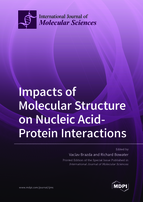Impacts of Molecular Structure on Nucleic Acid-Protein Interactions
A special issue of International Journal of Molecular Sciences (ISSN 1422-0067). This special issue belongs to the section "Molecular Biophysics".
Deadline for manuscript submissions: closed (30 June 2022) | Viewed by 62174
Special Issue Editors
Interests: relationship between DNA structure and function; interaction of proteins with DNA, local DNA structures and DNA damage; p53 protein and carcinogenesis; bioinformatics; immunology; neurosciences; neurodegeneration
Special Issues, Collections and Topics in MDPI journals
Interests: relationship between DNA structure and function; interaction of proteins with nucleic acids; genome damage and repair mechanisms; nucleic acid ligases; biochemical and biophysical chemistry education
Special Issue Information
Dear Colleagues,
Interactions between nucleic acids and proteins are some of the most important interactions in biology because many are essential requirements for the viability of cellular life. These interactions are indispensable for many basic biological processes, such as replication, transcription, and recombination. DNA is typically presented as a double stranded B-DNA structure, which is usually referred to as its canonical structure, but nucleic acids have great structural flexibility. This is especially true for RNA, but it is also clear that DNA can adopt many structural variations. Current knowledge demonstrates that the structural conformations of nucleic acids—their topologies—play critical roles in protein–DNA interactions. Several non-canonical structures have been shown to be effective targets for proteins, and they are implicated to play important roles in a range of human diseases, including cancer.
Building on recent research findings, we aim to cover important and new aspects of protein binding to sequence-specific nucleic acid targets, with emphasis on interactions that involve non-canonical DNA structures, such as G-quadruplexes, i-motifs, triplexes, and cruciform structures. We welcome contributions that involve biophysical, biochemical, and molecular biological, as well as bioinformatics, approaches for analyses of these systems. Authors are invited to submit original research in all areas of protein–nucleic acids research and/or reviews of recent work in this area. Topics considered to be appropriate include all impacts of non-canonical structures of nucleic acids, from biological activity to structure, from detection methods to their protein targeting, providing molecular insight and novel physiological and pathological functions or regulatory mechanisms of non-canonical DNA structures and their protein recognition. Submitted papers can refer to in vitro studies or can involve any cellular system or model organism.
We look forward to receiving your contributions to this Special Issue on “Impacts of Molecular Structure on Nucleic Acid–Protein Interactions”.
Dr. Vaclav Brazda
Dr. Richard Bowater
Guest Editors
Manuscript Submission Information
Manuscripts should be submitted online at www.mdpi.com by registering and logging in to this website. Once you are registered, click here to go to the submission form. Manuscripts can be submitted until the deadline. All submissions that pass pre-check are peer-reviewed. Accepted papers will be published continuously in the journal (as soon as accepted) and will be listed together on the special issue website. Research articles, review articles as well as short communications are invited. For planned papers, a title and short abstract (about 100 words) can be sent to the Editorial Office for announcement on this website.
Submitted manuscripts should not have been published previously, nor be under consideration for publication elsewhere (except conference proceedings papers). All manuscripts are thoroughly refereed through a single-blind peer-review process. A guide for authors and other relevant information for submission of manuscripts is available on the Instructions for Authors page. International Journal of Molecular Sciences is an international peer-reviewed open access semimonthly journal published by MDPI.
Please visit the Instructions for Authors page before submitting a manuscript. There is an Article Processing Charge (APC) for publication in this open access journal. For details about the APC please see here. Submitted papers should be well formatted and use good English. Authors may use MDPI's English editing service prior to publication or during author revisions.
Keywords
- protein-DNA
- recognition sequence
- DNA topology
- DNA structure
- G-quadruplex
- i-motif
- inverted repeat
- cruciform structure
- sequence analysis
- non-canonical DNA








